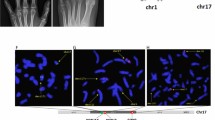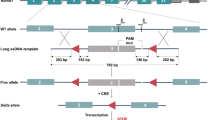Abstract
Mutations in T-box genes are associated with numerous disease states in humans. The objective of this paper was to characterize the T shao, a specific T-box mutation, in mice. T shao, a short-tailed mutant mouse strain in a B6 background, was obtained by ethylnitrosourea mutagenesis. Microsatellite genomic scans mapped the location of the mutation. RT–PCR was used to amplify the identified region and the product was sequenced. DNA of the region was sequenced and scanned for mutations. Tails of T shao mice were mostly curly with tail length ranging from less than 1 cm (tail bud) to half of the normal length. T shao presented single dominance gene inheritance, and homozygous mutant mice died approximately at E10. Scans of the F2 generation mapped the mutant gene to chromosome 17, near D17Mit143. The Brachyury (T) gene was identified as a potential candidate gene in this location. To confirm this, RT–PCR was performed on RNA from intercrossed 8.5-day embryos, and products were sequenced. A 67-nucleotide deletion in exon 2 of the mutant T gene was identified. Further sequencing of the genomic DNA from this region identified a T to A transversion at the 67th nucleotide of exon 2. The T shao mutation is a result of a deletion in exon 2 causing the early termination and loss of function of protein encoded by the T gene, manifesting as a short tail phenotype.



Similar content being viewed by others
References
Dobrovolskaïa-Zavadskaïa, N. (1927). Sur la mortification spontanée de la queue chez la souris nouveau-née et sure l’existence d’un caractère heriditaire ‘non-viable’. Comptes Rendus des Seances de la Societe de Biologie et de Ses Filiales, 97, 114–116.
Herrmann, B. G., Labeit, S., Poustka, A., King, T. R., & Lehrach, H. (1990). Cloning of the T gene required in mesoderm formation in the mouse. Nature, 343, 617–622.
Chesley, P. (1935). Development of the short-tailed mutant in the house mouse. Journal of Experimental Zoology, 70, 429–459.
Kispert, A., & Herrmann, B. G. (1993). The Brachyury gene encodes a novel DNA binding protein. EMBO Journal, 12, 3211–3220.
Agulnik, S. I., Bollag, R. J., & Silver, L. M. (1995). Conservation of the T-box gene family from Mus musculus to Caenorhabditis elegans. Genomics, 25, 214–219.
Bollag, R. J., Siegfried, Z., Cebra-Thomas, J. A., Garvey, N., Davison, E. M., & Silver, L. M. (1994). An ancient family of embryonically expressed mouse genes sharing a conserved protein motif with the T locus. Nature Genetics, 7, 383–389.
Chiba, S., Jiang, D., Satoh, N., & Smith, W. C. (2009). Brachyury null mutant-induced defects in juvenile ascidian endodermal organs. Development, 136, 35–39.
Packham, E. A., & Brook, J. D. (2003). T-box genes in human disorders. Human Molecular Genetics, 12(Spec No 1), R37–R44.
Shao, Y. X., Chen, B., Zhang, C. X., Chen, C. B., Xue, Z. F., & Li, H. D. (2005). Generating a tail-short mouse using ENU mutagenesis and mapping of the mutant gene. Chinese Journal of Zoology, 40, 8–13.
Sambrook, J., Fritsch, E. F., & Maniatis, T. (1989). Molecular cloning: A laboratory manual (2nd ed.). New York: Cold Spring Harbor Laboratory Press.
Wu, B. J., Mao, H. H., Shao, Y. X., Xue, Z. F., & Li, H. D. (2003). Four kinds of ENU-induced white spot mice and chromosome locations of the mutant genes. Chinese Science Bulletin, 48, 2301–2307.
Ruvinsky, I., Chertkov, O., Borue, X. V., Agulnik, S. I., Gibson-Brown, J. J., Lyle, S. R., et al. (2002). Genetics analysis of mouse mutations abnormal feet and tail and rough coat, which cause developmental abnormalities and alopecia. Mammalian Genome, 13, 675–679.
Silver, L. M. (1985). Mouse t haplotypes. Annual Review of Genetics, 19, 179–208.
Fujimoto, A., Wakasugi, N., & Tomita, T. (1995). A novel partial t haplotype with a brachyury-independent effect on tail phenotype. Mammalian Genome, 6, 396–400.
Rennebeck, G., Lader, E., Fujimoto, A., Lei, E. P., & Artzt, K. (1998). Mouse Brachyury the second (T2) is a gene next to classical T and a candidate gene for tct. Genetics, 150, 1125–1131.
Herrmann, B. G. (1991). Expression pattern of the Brachyury gene in whole-mount TWis/TWis mutant embryos. Development, 113, 913–917.
Herrmann, B. G., & Kispert, A. (1994). The T genes in embryogenesis. Trends in Genetics, 10, 280–286.
Bogani, D., Warr, N., Elms, P., Davies, J., Tymowska-Lalanne, Z., Goldsworthy, M., et al. (2004). New semidominant mutations that affect mouse development. Genesis, 40, 109–117.
Abe, K., Yamamura, K., & Suzuki, M. (2000). Molecular and embryological characterization of a new transgene-induced null allele of mouse Brachyury locus. Mammalian Genome, 11, 238–240.
Rashbass, P., Cooke, L. A., Herrmann, B. G., & Beddington, R. S. (1991). A cell autonomous function of Brachyury in T/T embryonic stem cell chimaeras. Nature, 353, 348–351.
Edwards, Y. H., Putt, W., Lekoape, K. M., Stott, D., Fox, M., Hopkinson, D. A., et al. (1996). The human homolog T of the mouse T(Brachyury) gene; gene structure, cDNA sequence, and assignment to chromosome 6q27. Genome Research, 6, 226–233.
Holland, P. W., Koschorz, B., Holland, L. Z., & Herrmann, B. G. (1995). Conservation of Brachyury (T) genes in amphioxus and vertebrates: Developmental and evolutionary implications. Development, 121, 4283–4291.
Agulnik, I. I., Agulnik, S. I., Saatkamp, B. D., & Silver, L. M. (1998). Sex-specific modifiers of tail development in mice heterozygous for the brachyury (T) mutation. Mammalian Genome, 9, 107–110.
Morrison, K., Papapetrou, C., Attwood, J., Hol, F., Lynch, S. A., Sampath, A., et al. (1996). Genetic mapping of the human homologue (T) of mouse T(Brachyury) and a search for allele association between human T and spina bifida. Human Molecular Genetics, 5, 669–674.
Jensen, L. E., Barbaux, S., Hoess, K., Fraterman, S., Whitehead, A. S., & Mitchell, L. E. (2004). The human T locus and spina bifida risk. Human Genetics, 115, 475–482.
Hue, I., Renard, J. P., & Viebahn, C. (2001). Brachyury is expressed in gastrulating bovine embryos well ahead of implantation. Development Genes and Evolution, 211, 157–159.
Papapetrou, C., Drummond, F., Reardon, W., Winter, R., Spitz, L., & Edwards, Y. H. (1999). A genetic study of the human T gene and its exclusion as a major candidate gene for sacral agenesis with anorectal atresia. Journal of Medical Genetics, 36, 208–213.
Park, J. C., Chae, Y. K., Son, C. H., Kim, M. S., Lee, J., Ostrow, K., et al. (2008). Epigenetic silencing of human T (brachyury homologue) gene in non-small-cell lung cancer. Biochemical and Biophysical Research Communications, 365, 221–226.
Krukovskaia, L. L., Polev, D. E., Nosova Iu, K., Baranova, A. V., Koliubaeva, S. N., & Kozlov, A. P. (2008). Investigation of transcription factor Brachyury (T) expression in human normal and tumor tissues. Voprosy Onkologii, 54, 739–743.
O’Donnell, P., Tirabosco, R., Vujovic, S., Bartlett, W., Briggs, T. W., Henderson, S., et al. (2007). Diagnosing an extra-axial chordoma of the proximal tibia with the help of brachyury, a molecule required for notochordal differentiation. Skeletal Radiology, 36, 59–65.
Oakley, G. J., Fuhrer, K., & Seethala, R. R. (2008). Brachyury, SOX-9, and podoplanin, new markers in the skull base chordoma vs chondrosarcoma differential: A tissue microarray-based comparative analysis. Modern Pathology, 21, 1461–1469.
Palena, C., Polev, D. E., Tsang, K. Y., Fernando, R. I., Litzinger, M., Krukovskaya, L. L., et al. (2007). The human T-box mesodermal transcription factor Brachyury is a candidate target for T-cell-mediated cancer immunotherapy. Clinical Cancer Research, 13, 2471–2478.
Acknowledgments
Authors would like to offer special thanks to MedSci editing for language revision and their expertise regarding this paper. This work was supported by the National Natural Science Foundation of China (30670231 to Baojin; 30671081 to Yixiang), Lab Animal Science and Technology Project of Zhejiang Province (No. 2009F80022) and SRF for ROCS, SEM.
Conflict of interest
The authors declare that they have no competing interests.
Author information
Authors and Affiliations
Corresponding author
Additional information
Baojin Wu and Yixiang Shao contribute equally to this paper.
Rights and permissions
About this article
Cite this article
Wu, B., Shao, Y., Chen, B. et al. Identification of a Novel Mouse Brachyury (T) Allele Causing a Short Tail Mutation in Mice. Cell Biochem Biophys 58, 129–135 (2010). https://doi.org/10.1007/s12013-010-9097-9
Published:
Issue Date:
DOI: https://doi.org/10.1007/s12013-010-9097-9




